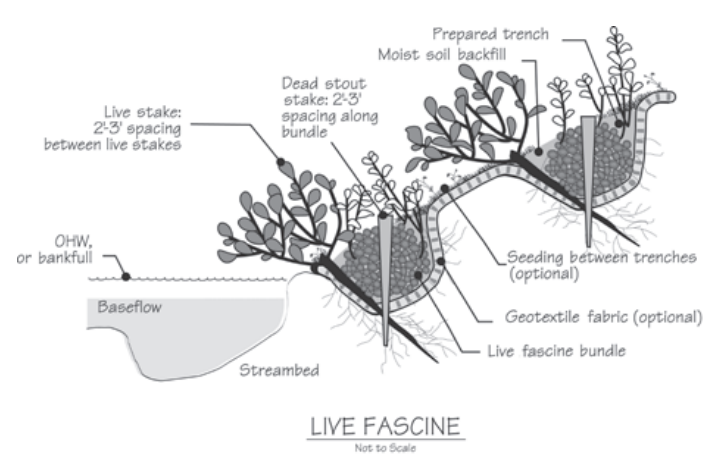Application: Bridges, canals, drainage, dykes, embankments, roads, footpaths, wastewater treatment plants
Description: Live fascines are long bundles of live woody vegetation buried in a streambank in shallow trenches placed parallel to the flow of the stream. The plant bundles sprout and develop a root mass that will hold the soil in place and protect the streambank from erosion. They act as a water retention system when placed horizontally or can serve as a drainage system if installed at a slight angle. Live fascines are also used to bench eroded slopes or gullies and to improve infiltration and other riparian zone functions. In conjunction with other methods, fascines can be used to protect the toe of brush mattresses, and the top leading edge of crib walls. They can also be used to "soften" existing rock rip-rap, gabion baskets, or concrete blocks, by placing them along the top edge of the stone, or if possible, along the edge of the water.
Contribution to climate resilience: Live fascines are most useful in controlling erosion in weak and unconsolidated materials, where deep gullies might form, and are often used to stabilize long slopes. By these means, they increase the resilience of stream banks to extreme climatic events.
Supplementary sources of information:
<http://projects.geosyntec.com/npsmanual/Fact%20Sheets/Live%20Fascines.pdf
https://water.ohiodnr.gov/portals/soilwater/pdf/stream/stfs14.pdf
http://riparianhabitatrestoration.ca/575/livefascines.htm
http://www.ontariostreams.on.ca/PDF/OSRM/Tech9.pdf
https://www.wilderness.net/toolboxes/documents/restoration/pdf06232815dpi72pt09.pdf
http://www.bender-rekultivierungen.de/en/services/bioengineering/
Background image credit: ICEM
This resilience-building measure is sourced from the Water Resource Adaptation Guide (2019) published by the National Council for Sustainable Development at the Ministry of Environment in Cambodia. The full Guide is available to download at URL https://ncsd.moe.gov.kh/sites/default/files/2019-10/Water%20Resources%20Adaptation%20Guide_March%202019_En.pdf


